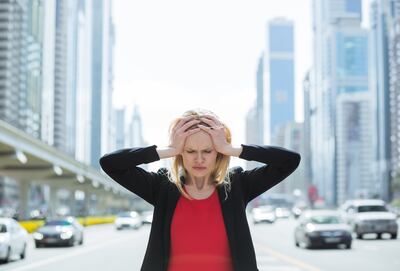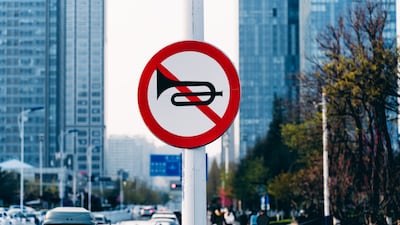In movies and TV shows, there’s a scene commonly filmed in cars to show a moment of relief. A character gets into the driver’s seat, shuts the door, and before clasping the seatbelt and turning on the ignition, leans back against the headrest and exhales. The scene doesn’t require dialogue. It’s universally understood as a breather, to collect oneself and shut out the world and all its never-ending noise.
Depending on who you ask, it rings true to life. After a day in the outside world with your game face on, who doesn’t enjoy a moment of silent car acoustics? All that panelling, padding and metal shutting out the world.
But what do you do when there is no car and there is no peace and you’re just in the middle of everyday city mayhem? The surround sound of urban environments, let’s face it, is not all bird song and rustling grasses.
There is also that unpleasant link between anxiety and noise pollution. I don’t want to make this a science digest, but basically, some people are more susceptible and sensitive to auditory triggers – loud chewing, leaky taps, obnoxious hairdryers and so on. It didn't thrill me to learn that women are reportedly more prone to misophonia, or a decreased tolerance to certain sounds.
Surely, it’s better for all people, with or without blood pressure issues, to not subject themselves to the neighbours upstairs moving furniture around or other such vile ambushes. At one time, I couldn’t bear the sound of Thermocol, the wilder cousin of Styrofoam. Those were the years when electronic gadgets came in those boxes.
Honestly, lucky are those people not too bothered by the shuffling, whirring, thudding and feet dragging that are the atmospheric givens of daily life. You might even think there are two kinds of people – those indifferent to sound, volume, screechy voices, high-pitched laughs; and then the other, perpetually troubled kind, for whom long spells of bad acoustics can ruin good days.

I came across an interesting nugget about aircraft take-off and landing sounds, their effects on people who live under the flight path, and the question of how loud is too loud. The researcher said: "Anything that makes you alter your behaviour". So, if you’re getting up to close the windows or to sit elsewhere, that’s too loud.
This is not to say that people sensitive to sound are wet blankets and want only quiet or are only ever ringing the building concierge to complain about the party in the apartment diagonally above. No, in the metaphoric catalogue of noise, silence is often, but not always at the absolute premium.
It can often be wonderful to sit around a table over a meal, listening to voices of differing pitches and ranges tell stories, interspersed with a low din of activity – the clinks and rings of cutlery and glasses and the softened movement of furniture (bless the inventor of those stick-on floor protectors made of felt for chair legs).
It is merely a question of volume and frequency and basic civic sense. I cannot understand people who take phone calls in the lift. Just call the person back. Or tell them to hold. Or at least make the pretence of cupping your hand to the phone. There are too many instances any given day where courtesy clashes with cacophony.
A couple of weeks ago, I delighted in an anecdote of a friend's friend, a serious musician, not being able to continue a conversation in a cafe. It sounded familiar. All the ceramic cups and saucers banging about on surfaces were too sharp for his ears. Those open industrial ceilings where you can see the A/C ducts probably don't help muffle frequencies. It’s the inverse of how wall-to-wall carpeting in bedrooms do help.
Thankfully, there's something being done about this. In July, Abu Dhabi announced it has set up a committee to discover the sources of noise pollution and compile a list of the neighbourhoods worst affected. The hope is that noise mapping will then help the authorities create sound barriers and more green spaces. It's a known fact that sustained noise pollution can add to stress, disturb sleep and even cause cardiovascular problems.
But it can be impolite to go around telling people to pipe down and talk softly. And often the culprits are not even people. It’s the machines and the construction and the wind-corridors and the general hustle-bustle of life.
And while there isn't much you can do to stop the chaos, here’s what I do, and I can’t stop telling people this, as if it equals the discovery of penicillin: You wear earplugs.

“Noise mitigation strategies," as medical professionals say. You buy a pair of noise reduction ear plugs, or a couple of pairs, and scatter them around the places where you can reach them when you most need them – office drawer, bedside table, handbag. The research regarding which one, what kind, which colour, is an adventure too, provided you find Amazon reviews as riveting as some of us.
Just remember, it's noise reduction, not noise cancellation. The distinction is important as the latter can be too insulating and unsafe if you’re out and about near traffic – even though the World Health Organisation says one in five people, or 100 million people globally, are exposed to unhealthy levels of road traffic noise.
And I’m talking about the simple earplugs, not the more expensive noise cancellation, Bluetooth-enabled head/ear phones, which are great. But just the discreet, light, washable, silicone plugs (foam ones are less effective) will do. They don’t announce themselves, and they help you stay engaged enough with your environment. They can also put you in an okay mood because they reduce decibels a crucial little bit and that makes all the difference. It works well because you can focus on work and not be annoyed. And it’s easier to smile at people when there is no rage.
Given the ambient obstacles of our times, the armour to protect ears does wonders to shush everything down a notch, soothe anxiety and, with any luck, keep heart attacks at bay. Deep breathing is, of course, the free gold standard, ask any monk. But this cacophony mitigation strategy – much cheaper than sound proofing an apartment – replicates the relief of a silent car cocoon just about anywhere. More people should try it.


